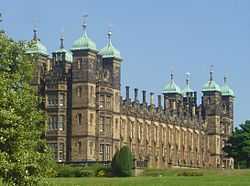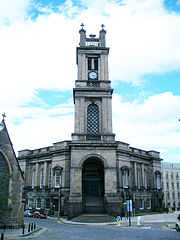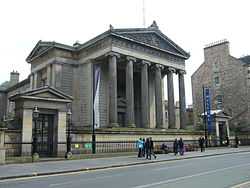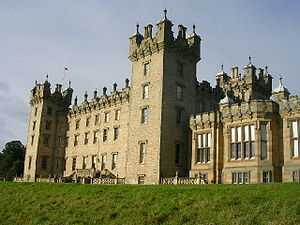William Henry Playfair

William Henry Playfair FRSE (15 July 1790 – 19 March 1857) was one of the greatest Scottish architects of the 19th century, designer of many of Edinburgh's neo-classical landmarks in the New Town.
He was born in 15 July 1790 in Russell Square, London, to James Playfair and Jessie Graham.[1] Playfair's father was also an architect, and his uncles were John Playfair, the scientist, and William Playfair, an economist and pioneer of information graphics.
Two of his finest works are the neo-classical buildings of the National Gallery of Scotland and the Royal Scottish Academy which are situated in the centre of Edinburgh. The Playfair Project completed in 2004 joined the two historic buildings with an underground link.
Playfair joined the Free Church following the Disruption of 1843,[2] losing his right to burial in the parish churchyard.
Playfair took David Cousin under his wing and was responsible for the latter part of his training.
Playfair died in Edinburgh on 19 March 1857, and is buried in the "Lord's Row" on the western wall of Edinburgh's Dean Cemetery, where he designed a number of monuments for others, including Lord Jeffrey.
Timeline of major projects


- 1817 Appointed architect to complete design work on the Old College, University of Edinburgh, on the basis of his proposals to complete the plans originated by Robert Adam. The building was completed around 1831.
- 1818 Commissioned by the will of the late Captain John McNab to design Dollar Academy, where a building is now named after him
- 1820 Calton New Town, Edinburgh (includes Regent Terrace and Royal Terrace), completed only in 1860
- circa 1820 City Observatory, Calton Hill
- 1821-24 Royal Terrace, New Town, Edinburgh only completed in 1860
- 1822 Commissioned by the Institution for the Encouragement of Fine Arts in Scotland. The building was opened in 1826 and is now the Royal Scottish Academy Building, Edinburgh
- 1823 Royal Circus, New Town, Edinburgh
- 1824 In collaboration with Charles Robert Cockerell, designed an exact replica of the Parthenon which was to be built on top of Calton Hill as the National Monument, Edinburgh. However due to lack of investment it was never finished and became known as Edinburgh's Disgrace.
- 1825 Regent Terrace, New Town, Edinburgh
- 1826 John Playfair Monument, (he was William Henry's uncle), Calton Hill, Edinburgh
- 1827 - 1828 St Stephen's Church, St Stephen's Place, Silvermills, Edinburgh
- 1829 Drumbanagher House (demolished)
- 1830 - 1832 For the Royal College of Surgeons of Edinburgh, Surgeons' Hall, Nicolson Street, Edinburgh
- 1831 Dugald Stewart Monument, Calton Hill, Edinburgh
- circa 1837 renovations to Floors Castle, outskirts of Kelso, Scottish Borders
- 1846 - 1850 New College, Edinburgh
- August 30, 1850 Prince Albert laid the foundation stone of the National Gallery of Scotland. adjacent to The Royal Scottish Academy.
- 1851 Donaldson's College, Edinburgh
- 1852 Dunstane House - now a Hotel in west of Edinburgh
- 1859 National Gallery of Scotland opened to the public two years after Playfair's death.
Gallery of architectural work
-

Donaldson's College, Edinburgh 1851
-

Old College, Edinburgh University
-

Old College, Edinburgh University
-

City Observatory, Edinburgh
-

Three Edinburgh buildings by Playfair
-

Royal Scottish Academy
-

Royal Scottish Academy frontage
-

Sphinxes on the Royal Scottish Academy
-
Regent Terrace, Edinburgh
-

John Playfair Monument, Calton Hill, Edinburgh
-

St. Stephen's Church Edinburgh
-

Surgeons' Hall, Edinburgh
-

Dugald Stewart Monument, Calton Hill, Edinburgh
-

Floors Castle, near Kelso
-

New College, Edinburgh
-

National Gallery of Scotland, Edinburgh
References
Sources
External links
![]() "Playfair, William Henry". Dictionary of National Biography. London: Smith, Elder & Co. 1885–1900.
"Playfair, William Henry". Dictionary of National Biography. London: Smith, Elder & Co. 1885–1900.
- Dictionary of Scottish Architects
- Dictionary of Scottish Architects- William Henry Playfair
- Gazetteer for Scotland Details
- William Henry Playfair's buildings in Edinburgh
- Portrait
|
